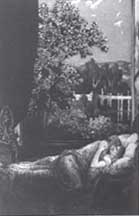Max Klinger was born in Leipzig in 1857 and studied art at 16 at the Academy of Fine Arts of Karlsruhe. Klinger soon moved to Berlin with Gussow, his master and worked in the studio of Boecklin.

His first exhibition took place in 1878 when he showed a painting titled «strollers» as well as a series of drawingsrelating to the life of Christ.
His audacity was harshly criticised and he had far more enemies when the National Gallery of Berlin acquired his drawings.
Klinger however did not give up his audacious style and started to learn the art of engraving by himself. After producing many etchings and aquatints, he faced renewed hostility among the critics and the public and decided to travel throughout Europe.
He first settled in Brussels where he copied Flemish old masters and then went to Austria, to Paris, to Munich and then to Rome where he stayed between 1888 and 1892.
Back in Germany, he chose to remain in Leipzig instead of Berlin and finally managed to obtain some respect from art amateurs.

Klinger then treated many philosophical themes which formed the best part of his work such as the «Blue Hour», «Nymph by the seaside» and his famous «Crucifixion», which prompted many controversial comments since he had introduced in that painting figures with modern clothes.
He also was interested in Brahms' symphonies, which were connected to certain of his paintings and thus proved to be one of the pioneers of Surrealism.
In 1895, Klinger taught at Academy of Fine Arts of Vienna but soon resigned from his post as he was too independent-minded to stick to theoretical teaching.
He then took to sculpture and proved again to be a modernist producing painted marble statues with incredible audacity.